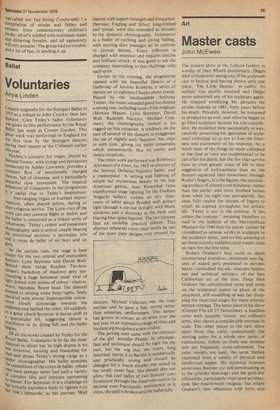Art
Master casts
John McEwen
The present show at the Lefevre Gallery is worthy of their fiftieth anniversary. Degas died without ever seeing any of his sculpture cast in bronze and having shown only one piece, 'The Little Dancer', in public. Its realism was poorly received and Degas never submitted any of his sculpture again. He stopped exhibiting his pictures for similar reasons in 1881, forty years before his death. Privately, however, he remained as productive as ever, and when he began to go blind sculpture became his sole consolation. He modelled most successfully in wax, carefully preserving his ignorance of sculptural technique so as not to lose the freshness and excitement of his response. As a result most of the things he made collapsed at the time or were too insubstantial to be cast after his death, but the few that survive have an even greater sense of life in their suggestion of awkwardness than do the dancers squeezed into movement through Rodin's fingers. It is the figures, the astonishing product of almost total blindness, rather than the earlier and more finished horses done when his sight was unimpaired, that most fully realise the dictum of Ingres to which he aspired throughout his artistic life: 'Form is not in the contour. It lies within the contour.' Amazing therefore to read in the bulletin of the Metropolitan Museum for 1946 that the pieces 'cannot be considered as serious works in sculpture in the academic sense,' and no less amazing to see these recently authenticated master casts on view for the first time.
Robert Graham's first work to claim international attention—miniature wax figures of naked girls presented in perspex boxes—embodied the wit, innocent hedonism and technical intricacy of the best Californian art of the time. Since then Graham has concentrated more and more on the sculptural aspect in place of the anecdotal, still modelling in wax but dropping the theatrical stages for more totemic bronze castings. The latest piece in his show (Gimpel Fils till 27 November), a headless torso with (usually 'torsos' are without) arms, also shows a considerable increase in scale. The other pieces in the new show apart from this torS.o, undoubtedly the starting point for a whole new series of explorations, follow on from one another and are frequently cross-referential. The same models are used, the same themes examined from a variety of physical and intellectual angles. His technical interests sometimes become too self-perpetuating as in the cylinder drawings; and the gold-leaf silhouettes, particularly when used as inlays, look like board-room insignia: but where Graham's new obsession with form and
texture is balanced, these latest works display an awareness of tradition, a new degree of seriousness which far outweighs the playfulness they have replaced. And the last piece is the best.











































 Previous page
Previous page